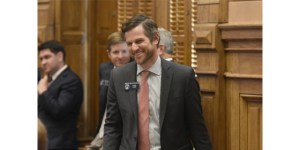Mark Millican: The wall that hasn’t yet fallen
Published 11:02 pm Sunday, May 25, 2014
Teresa noted my pensiveness at breakfast Friday morning.
Trending
“What’s on your mind?” my wife asked.
Memorial Day weekend. My Great-Uncle Shields. A column.
Shields Norman, on dad’s side of the family. This man I could still see in my mind’s eye from childhood was making an appearance. A former resident of LaFayette, he had survived the Allied invasion of Italy at Salerno during World War II. But it came at a high price — he sustained shrapnel wounds in one hip that plagued him the rest of his days.
Around 35 years ago he took his own life because of the constant pain. The wound struck deep, and surgery at that time may have caused him to bleed to death.
Also on my mind was the replica of the Vietnam Veterans Memorial I had visited in Ellijay the day before. It’s not the same as the one in Washington, of course, but this “traveling wall” carries that same somber and obdurate presence and the collective specter of the thousands of dead war vets it represents.
Seeing men and women with gray in their hair, perhaps cradling a grandbaby in their arms or holding a child by the hand and looking for a name on the wall of a long-gone relative or old friend, touches me deeply. It’s the same feeling I’ve gotten at the World War II Memorial in Washington, D.C. when I’ve witnessed grizzled veterans, using canes or being pushed in wheelchairs, their vests and ball caps adorned with medals and mementoes, sometimes with tears rolling down their cheeks.
Trending
My late father was in the initial phase of training to become a Navy pilot when WW II ended. He told me on more than one occasion his “PT” (physical training) while a student at Young Harris College was conducted by a Marine Corps drill instructor who pushed them so hard all the trainees left puddles of sweat on the gym floor.
At age 18 in 1973 I registered for the draft. For those of you too young to know what that means, at one time military duty for young men during wartime was compulsory in this country unless you had an exemption, like college studies or a disability. Fortunately for me and my graduating male classmates, that was the same year our government began pulling troops out of Vietnam.
A few years later during basic training at Parris Island there were still a few ‘Nam veterans around. I know many vets from that era went on to become successful in business, family life and civic affairs. But the ones I saw who stayed in the Marine Corps — maybe that’s the only place they could still function — had the appearance of shells of men. They looked haggard, distant and cold. I don’t mean this to be humorous, but I’ve never seen a truer example of “The lights are on, but nobody’s home.”
The context is different, but the “welcome” home many in our 1970s culture gave Vietnam vets — calling them baby killers and war criminals — is equal in shame only to the proliferation of slavery and the “get the hell out” treatment some of our forefathers gave to Native Americans over two centuries ago.
Reality check: We owe these vets everything for the freedom we live under, even the right to protest that people in most of the world’s nations today do not enjoy. So tip your hat and step aside when a war veteran walks by. Indeed, all of them gave a lot, but some gave all. And listen to the survivors who can tell us how they died. You know, the ones whose tombstones prop up the wall that hasn’t yet fallen.
Mark Millican is a former Daily Citizen staff writer. You can follow him on Twitter, @ExtraByMark.




